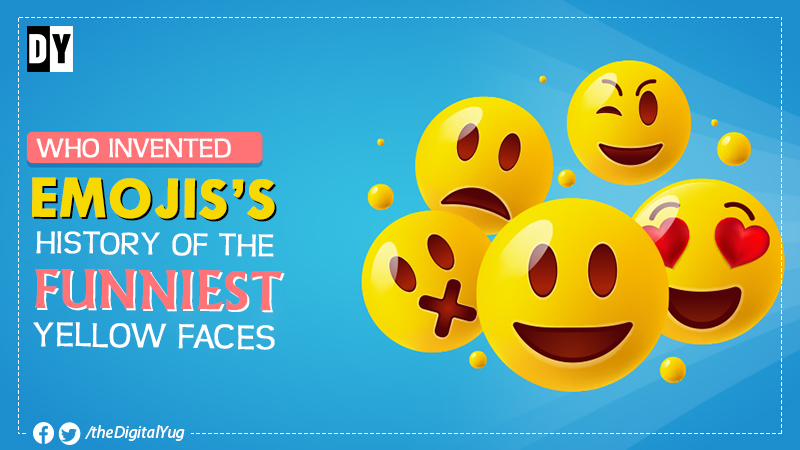
Can you imagine a world without emojis where you would have to express your emotions in words on chat? It's difficult and time-consuming. And we all will agree upon this that, instead of typing “oh that's funny, I laughed so much” we would prefer typing “LOL” or “ROFL” and complement it with ‘Face with Tears of Joy' emojis; simple and convenient. We also see people make use of emojis to end a conversation that no longer interests them or sometimes we see people starting a conversation by replying to a meme with an emoji. So what exactly is an emoji and who created it?
The invention of Emojis – How it Started?An emojis was created by Japanese artist Shigetaka Kurita in the year 1999. Emojis is a combination of Japanese words: ? “picture” + “Moji” ?? which roughly translates to the pictograph. A telecom company namely, NTT DoCoMo experimented with pictograms and released pagers for teenagers. The only downside was that they made use of only a “heart-shaped” pictogram. This created a buzz among the users and emojis got popularized so much so that when another pager for businessmen without the pictogram was released by the provider, people switched to one's with that offered pictograms. And this led NTT to reverse their decision and they made the heart-shaped pictogram available on that pager as well.
This need and demand for emojis among the people motivated Kurita to design a set of pictograms. He designed a set of 176 emojis with 12×12 pixels and this set of pictograms was popularly known as emojis. Kurita created these emojis by taking inspiration from Japanese manga characters, weather pictograms, and street signs. And today, Kurita's work is now displayed in the Museum of Modern Art in New York City.
Emoticons v/s EmojisBut here's a surprising fact, the yellow-faced emojis that we see today aren't evolved from Kurita's collection of emojis but emoticons.
Emoticons and emojis are two different concepts. Emoticons are used as a representation of facial expressions using punctuations like commas, apostrophes, semi-colon, colon, and many more. A creative mind could create as many as 100 emoticons using a combination of different punctuations.
These emoticons were used, unknowingly, by poet Robert Herrick in 1648 in his lines:
Tumble me down, and I will sit Upon my ruins, (smiling yet ? ”
And it was eventually created by Scott Dalman in the 1980s. And it's not until the early 1990's that digital smileys and emoticons were introduced on windows with the launch of the font Wingdings on Microsoft.
Emojis is like a successor of emoticons nowadays it is preferred over emoticons.
The Rise of Emojis SetsThe emojis set got popular in Japan in the year 2000. This year also marked the launch of I-mode by DoCoMo which included emojis in the messaging app. I-mode saw a subscription of 40 million people and the popularity of i-mode made the competitors introduce their own emojis set to stay relevant and in the competition. But these companies failed to deliver.
Later, the Universal Coded Character Set was established to create a standard set of emojis and they included many American and European iconic symbols in their emojis set. Unicode kept on updating their set by introducing a version like Unicode 4.0 which contained new 16 emojis in it.
With this many mobile manufacturers in North America and Europe saw the need of launching their own emojis set.
But it wasn't until Google and other companies like apple joined hands with Unicode to introduce a standard set of emojis for everyone around the world. In 2009, Unicode conducted many sessions to welcome suggestions and changes in the set and it was not until 2010 that Unicode launched the 6.0 version of their emojis set with 722 emojis. Over the year the organization kept on updating their set and adding new emojis, many from the Webdings and Wingdings fonts by introducing Unicode 7.0.
Unicode 8.0 offered 41 new emojis including articles of sports equipment such as the cricket bat, food items such as the taco, signs of the Zodiac, new facial expressions, and symbols for places of worship.
The increased demand for emojis created a lot of pressure on the Unicode Consortium as the members urged the organization to stick to standard emojis, whereas the organization was of another opinion. To suit the cultural differences, many emojis were added accordingly.
Emojis & TitlesIn the year 2015, Oxford dictionaries named ‘face with tears of joy as the word of the year. The American Dialect Society declared ‘Aubergine' as the ‘Most Notable Emojis’ of 2015. We see many emojis in the set which are directly based on the Japanese culture, some emojis like the ‘Blood drop’ create awareness about certain issues.
Final WordsPeople have found a way of communicating with emojis and I don’t think we can go back to a world with no emojis. Emojis make it easier to express when we are short of words, emojis put emotions in the conversation, emojis help us to say a lot without typing much. So to answer the question that I mentioned in the beginning; no, we cannot emojis a world without emojis. Although, sometimes use of emojis can lead to miscommunication. For some, one emojis can mean something and for others, it might hold some different meaning. For instance, the Dashing away Emojis' is often misinterpreted as farting, this emojis symbolizes the last moment of a person or vehicle, which is in a hurry of getting somewhere quickly. Nevertheless, we can't stop using emojis and we never can unless of course GIFs take over. But that's a different case for a different day.
Latest Updates from around the world
Most read stories, topics, and videos
Latest Updates from around the world